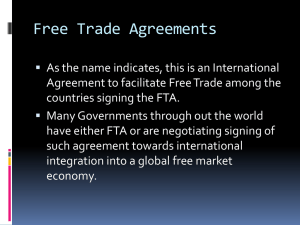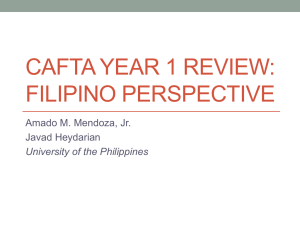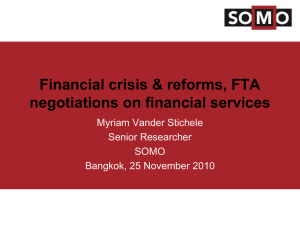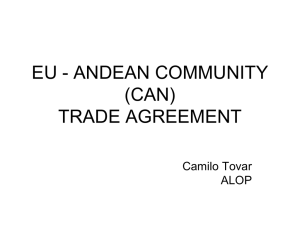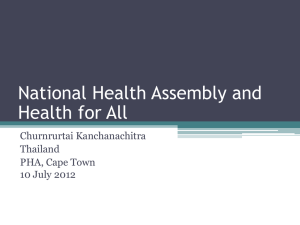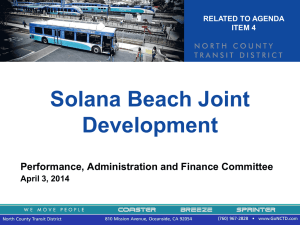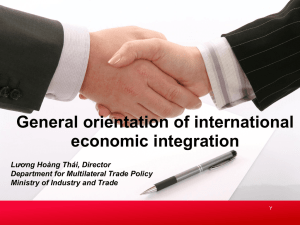Global trade rules
advertisement
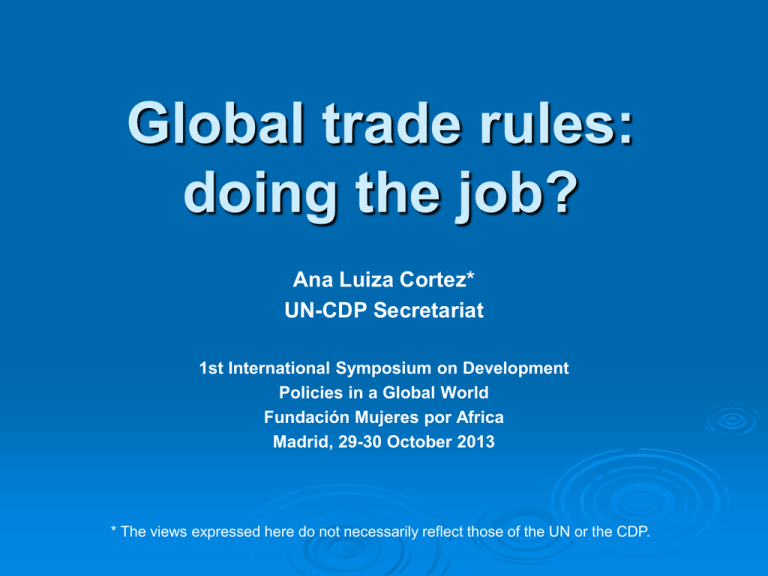
Global trade rules: doing the job? Ana Luiza Cortez* UN-CDP Secretariat 1st International Symposium on Development Policies in a Global World Fundaciόn Mujeres por Africa Madrid, 29-30 October 2013 * The views expressed here do not necessarily reflect those of the UN or the CDP. WTO RTA FTA FTA RTA PTA EPA AGOA FTA MERCOSUR RTA FTA EPA PTA FTA FTA BTA FTA UNCTAD PTA EPA WIPO RTA FTA RTA FTA EPA PTA FTA FTA FTA ICA FTA BTA RTA PTA RTA FTA EPA PTA FTA FTA BTA RTA FTA EPA FAO FTA RTA FTA EPA PTA FTA FTA ICA RTA FTA EPA PTA FTA FTA BTA EPA PTA FTA FTA NAFTA EPA PTA FTA FTA BTA RTA RTA FTA FTA RTA FTA RTA FTA EPA PTA FTA FTA BTA FTA FTA Global trade rules • Trade flows • Equity • Governance • Coherence Global trade rules: Current state of affairs 1. Trade flows Predicable and growing: MFN and national treatment Less than full reciprocity Dispute settlement machinery Small hiccups 2. Contributing to higher standards of living, full employment, real income growth? 3. Developing countries securing a share in trade growth compatible with development needs? 3. Developing countries securing a share in trade growth compatible with development needs? Patterns of insertion matter → what you produce matter: participation in dynamic markets How you produce matter linkages with he domestic economy Strategic trade liberalization: means to promote structural transformation (carrots and sticks) Strategic association with foreign investor Shrinking policy space (other culprits) Global trade rules = enablers? GATT/WTO are about trade liberalization, however, approach changed: Before the Uruguay Round: • Deviations from disciplines Special and differential treatment: BOP difficulties, protect/promote industries • Pick and choose • Less than full reciprocity of commitments (rules, tariffs, preferential access) • Not for free: exclusions, tariff peaks, tariff escalation → Shift in the development paradigm: role of the state, trade as an end → Rising importance in global trade (NICs) With the Uruguay Round: Single undertaking: additional commitments; adjustment costs SDTs: The old: preferential market access; fewer deviations with stricter disciplines; The new: flexibilities for implementation and procedures plus technical assistance: institutional capacity gaps WTO: Development = SDTs 139 provisions; several deficiencies • Best endeavor • Not enforceable • Add-ons • Offsets • Lacking coherence • Delinked • Insufficient • • Doha mandate SDTs to be strengthened, more effective, precise and operational (mandatory): “early harvest” status (2002) Disappearing proposals: >150 → condensed into 88 → 38 in Cat. I (“easy”) → 28 ; Cat. II (agreement specific): 38 → 6… We’re not in Kansas anymore… • Giants, dwarfs and the in-between • GVCs business model • PTAs/FTAs and BITs Decision making process Nature/scope of disciplines The future of SDTs A new generation of SDTs? Trend: from developing countries to individual country needs: • • • • • • Differentiation in WTO Differentiation by trading partners Linked to individual needs: inventory Implementation according to capacity, technical assistance Temporary No deviations, no exemptions Trend: the vanishing principle of “less than full reciprocity” • • Further reductions in policy space (advanced economy policy package) Sustainable dynamic transformation requires flexible rules adaptable to domestic conditions Moving forward Emerging approach: •Diversified developing world: SDTs based on needs implementation issues (definition, monitoring, etc.) •Graduation rules to be discussed multilaterally However, - SDTs = second best solution: equal rules to unequal partners. Right policy package? - For developing countries: development friendly/neutral rules X exceptions to the rules Summing up: - Stable and predictable flows not enough - Trade as a means: disciplines compatible with the needs of dynamic transformation of all economies Thank you!
